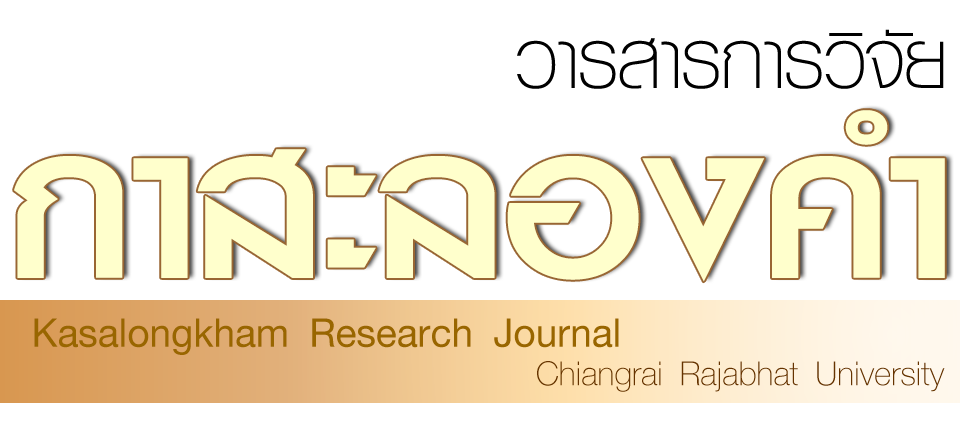การสร้างรูปแบบการเรียนการสอนตามทฤษฎีสรรคนิยมเพื่อส่งเสริม การให้เหตุผลทางคณิตศาสตร์ของนักศึกษาครู
คำสำคัญ:
รูปแบบการเรียนการสอน, การให้เหตุผลทางคณิตศาสตร์, การสอนตามทฤษฎีสรรคนิยม, ส่งเสริมการให้เหตุผล, การสร้างรูปแบบการเรียนการสอนบทคัดย่อ
บทคัดย่อ
คณิตศาสตร์เป็นศาสตร์ที่มีลักษณะและธรรมชาติเฉพาะตัว ซึ่งนักคณิตศาสตร์สร้างความรู้ทางคณิตศาสตร์ผ่านกระบวนการสืบเสาะทางคณิตศาสตร์สิ่งที่แฝงอยู่ในกระบวนการดังกล่าวคือ การให้เหตุผลทางคณิตศาสตร์ สถาบันการผลิตครูจำเป็นต้องตระหนักถึงการจัดการเรียนการสอนที่ส่งเสริมให้นักศึกษาครูได้รับประสบการณ์ตรงในการให้เหตุผลทางคณิตศาสตร์ โดยมีวัตถุประสงค์ 1) เพื่อสร้างและหาคุณภาพของรูปแบบการเรียนการสอน และ 2) เพื่อหาค่าดัชนีประสิทธิผลของรูปแบบการเรียนการสอน โดยประยุกต์ใช้กระบวนการวิจัยและพัฒนา เครื่องมือที่ใช้ในการวิจัย ได้แก่ 1) แบบประเมินรูปแบบการเรียนการสอน 2) รูปแบบการเรียนการสอน 3) แบบทดสอบวัดความสามารถการให้เหตุผลทางคณิตศาสตร์ กลุ่มประชากรที่ศึกษา คือ นักศึกษาสาขาคณิตศาสตร์ โดยคัดเลือกกลุ่มตัวอย่างแบบเจาะจง จำนวน 29 คน วิเคราะห์ข้อมูลโดยการหาค่าเฉลี่ย ส่วนเบี่ยงเบนมาตรฐานและค่าดัชนีประสิทธิผล ผลการวิจัย ได้รูปแบบการเรียนการสอนตามทฤษฎีสรรคนิยม เพื่อส่งเสริมการให้เหตุผลทางคณิตศาสตร์ของนักศึกษาครูที่มีคุณภาพ โดยผลการประเมินคุณภาพของรูปแบบการเรียนการสอนด้านความเหมาะสมโดยผู้เชี่ยวชาญ 7 ท่าน อยู่ในระดับมากที่สุดและผลการหาค่าดัชนีประสิทธิผลของรูปแบบการเรียนการสอนมีค่าเท่ากับ 0.62 ซึ่งรูปแบบการเรียนการสอนที่ผู้วิจัยได้พัฒนาและออกแบบกิจกรรมการเรียนรู้ EISDGA ประกอบด้วย ขั้นที่ 1 สำรวจปัญหา ขั้นที่ 2 แก้ปัญหา ขั้นที่ 3 แลกเปลี่ยนข้อสรุป ขั้นที่ 4 ตรวจสอบข้อสรุป ขั้นที่ 5 วางนัยทั่วไปและให้เหตุผล ขั้นที่ 6 ประยุกต์ใช้ในชีวิตประจำวัน เป็นแนวทางเหมาะสมในการจัดการเรียนการสอนคณิตศาสตร์ที่ช่วยส่งเสริมและพัฒนาการให้เหตุผลทางคณิตศาตร์สำหรับนักศึกษาครูได้อย่างมีประสิทธิภาพ
เอกสารอ้างอิง
American Association for the Advancement of Science (AAAS). (1993). Benchmarks for Science Literacy. New York: Oxford University.
Anderson, T. P. (1997). Using models of instruction. In C. R. Dills and A. J. Romiszowski (eds). Instructional Development Paradigms. Englewood Cliffs, NJ: Educational Technology Publications.
Buakhao, N., Nualpang, K. & Jenjit, A. (2019). The Effects of Learning Management Using 4E×2 Instructional Model and Higher-Order Questions on Mathematical Concepts and Reasoning Ability of Grade 8 students. Journal of Education Naresuan University, 24(1), 153-165.
Buason, R. (2011). Research and Development of Educational Innovations (2nd ed). Nakhon Sawan: Rimping Karnpim.
Buason, R. (2019). Research and Development of Educational Innovations. Bangkok: Chulalongkorn University Printing House.
Chupan, W., Panicharoen, K. & Prommas, J. (2020). The effects of cognitively guided instruction on think-pair-share techniques on mathematical reasoning ability and communicative competence of eighth grade students. e-Journal of Education Studies, Burapha University, 2(4), 1-13.
Dewey, J. (1910). How We Think. Boston: D.C. Health & co., publishers.
Dossey, J. A., et al. (2002). Mathematics methods and modeling for today’s mathematics classroom: A contemporary approach to teaching grades 7-12. Pacific Grove CA: Brooks/Cole.
Ernest, D. (1993). Management: Theory and Practice (4th ed). New York: McGraw-Hill Book Company.
Ernest, D. (1996). Personnel: Management People at Work. New York: The McMillan.
Fakkham, S., Nualpang, K. & Angganapattarakajorn, W. (2018). The Effects of Learning Management by Using Concept Attainment Model and Higher - Order Questions on Mathematical Concepts and Reasoning Ability of Mathayomsuksa II Students. Journal of Humanities and Social sciences Surin Rajabhat University, 20(2), 97-113.
Joyce, B., and Weil, M. (2009). Models of Teaching (8th ed). New York: Courtesy of Reece Galleries.
Joyce, B., Weil, M., and Calhoun E. (2009). Models of Teaching. Pennsylvania State University: Pearson/Allyn and Bacon Publishers.
Khaemmanee, T. (2007). INSTRUCTION MODEL: Various choices. Bangkok: Chulalongkorn University Printing House.
Lapyingyong, N. (2018). A Development of Learning Model of Mathematical Proofs for Abilities in Writing Proofs. Ratchaphruek Journal, 16(1), 37-45.
Norqvist, M., Jonsson, B., et al. (2019). Investigating algorithmic and creative reasoning strategies by eye tracking. The Journal of Mathematical Behavior, (55), 1-14.
Pattamavilai, K. and Uamcharoen, S. (2016). The Development of an Instructional Model to Enhance Reasoning, Problem Solving and Communication Skills in Mathematics of Eleventh Grade Students. Veridian E-Journal,Silpakorn University, 9(3), 377-391.
Phairojphiriyakun, N. (2021). The Development of Teaching and Learning Management Model to Enhance Mathematics Problem-Solving Competency for Mattayomsuksa 6 Students. Social Sciences Research and Academic Journal, 17(1), 17-31.
Phanphattanakun, K. (2012). Principles of Mathematics [Unpublished manuscript]. Faculty of Science and Technology, Chiang Rai Rajabhat University.
Phattaphon, M. (2019). Research and development for curriculum development and learning. Bangkok: Leadership Center for Curriculum Innovation and Learning.
Saiyot, L. and Saiyot, A. (1995). Educational Research Techniques (5th ed). Bangkok: Suweerivasarn Company Limited.
Singmui, CH. and Nilsrakhu, W. (2017). Ability to reason mathematically through integrated mathematics learning activities based on constructivist theory on probability. The 22nd Annual Meeting in Mathematics (AMM 2017), Proceedings of AMM 2017.
Slater, T. (1993). The Effectiveness of a Constructivist Epistemological Approach to the Astronomy Education of Elementary and Middle Level in Service Teachers. Dissertation Abstracts International, 54(7): 2528 A.
Stipek D. (2002). Motivation to learn: From theory to practice (4th ed). Needham Heights, MA: Allyn & Bacon
Von Glasersfeld, E. (2001). Radical constructivism and teaching. Perspectives, 31(2), http://vonglasersfeld.com/244.2

ดาวน์โหลด
เผยแพร่แล้ว
รูปแบบการอ้างอิง
ฉบับ
ประเภทบทความ
สัญญาอนุญาต
ลิขสิทธิ์ (c) 2023 วารสารการวิจัยกาสะลองคำ มหาวิทยาลัยราชภัฏเชียงราย

อนุญาตภายใต้เงื่อนไข Creative Commons Attribution-NonCommercial-NoDerivatives 4.0 International License.





